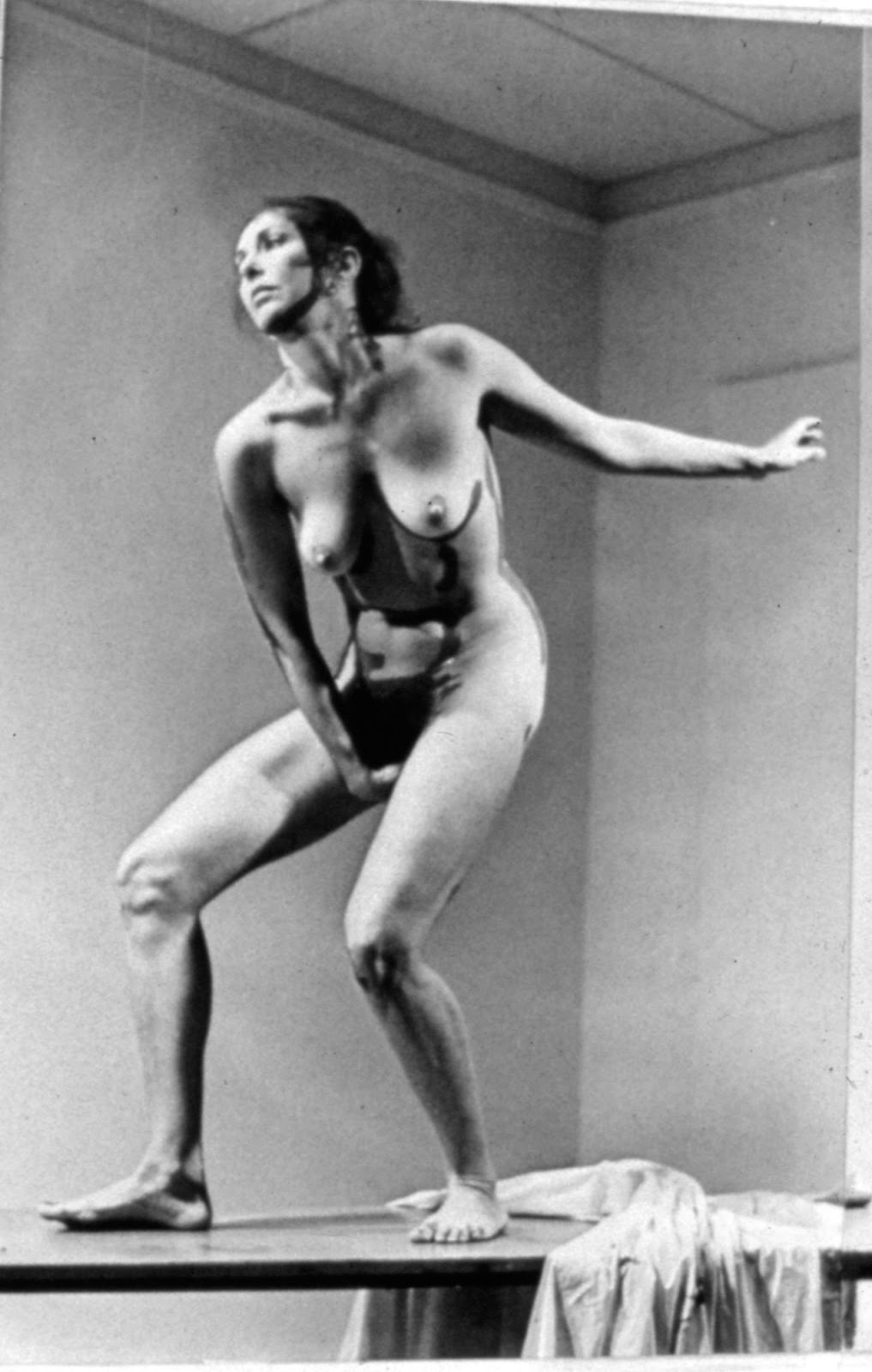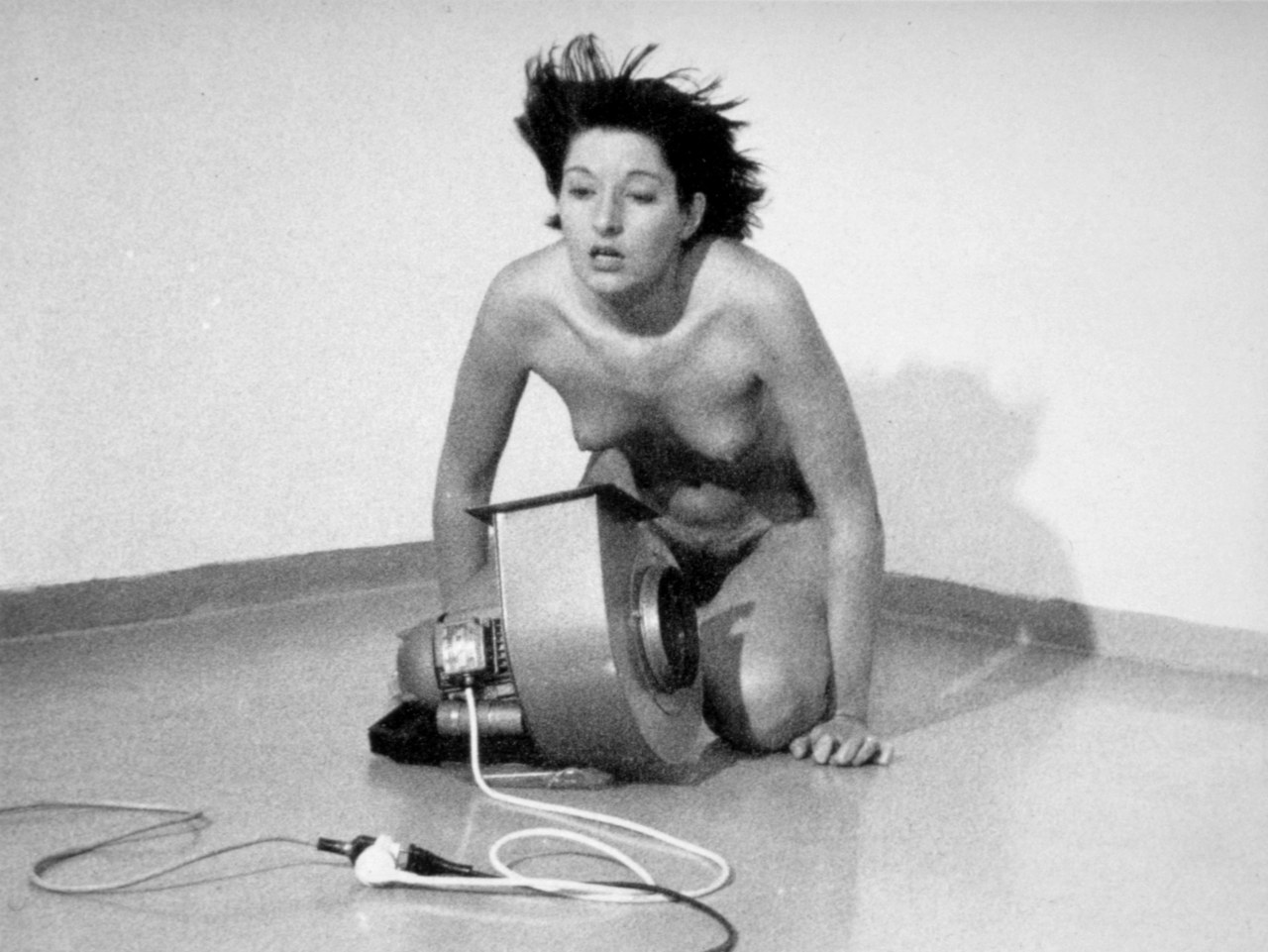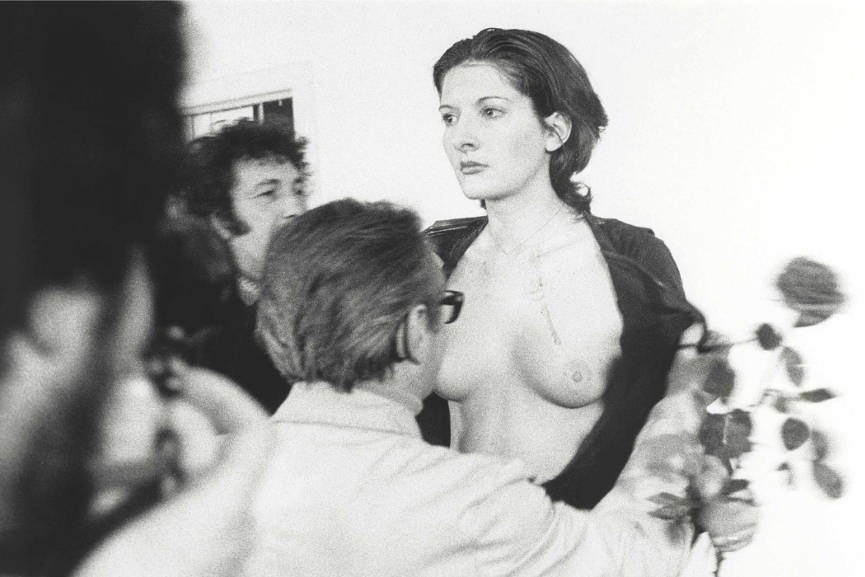Picture posted by Quinn Moreland on 29 August 2015

PHOTO: Carolee Schneemann, Interior Scroll (1975)
More than forty years ago on 29 August 1975, the thirty-six-year-old artist Carolee Schneemann pulled a scroll from her vagina.
The performance, titled “Interior Scroll,” is an essential moment in performance art history, and an important milestone in the artist’s provocative and influential oeuvre (the body of work of a painter).
Photo by Anthony McCall
Picture posted by Quinn Moreland on 29 August 2015
https://blogger.googleusercontent.com/img/b/R29vZ2xl/AVvXsEjbu8eNA5-2ZO7kDyee18AjE7Bpx7aGKvq6n2eVAtQ7Ys2MpvTFDS8pDc_XE_v0t5_7NpAzX3Zoofh-Gcfvh6OGlVAHVWCF2o7Y_WnrmFYkYjvbrmOfwfyMtEJj17gTUPsf-P9wGI2bvYA/s1600/1975InteriorScroll_002.jpg
http://hyperallergic.com/wp-content/uploads/2015/08/1975InteriorScroll_002.jpg
http://hyperallergic.com/232342/forty-years-of-carolee-schneemanns-interior-scroll/
Forty years ago on August 29, 1975, the thirty-six-year-old artist Carolee Schneemann pulled a scroll from her vagina. The performance, titled “Interior Scroll,” is an essential moment in performance art history, and an important milestone in the artist’s provocative and influential oeuvre (the body of work of a painter).
In front of an audience comprising mainly women artists, Schneemann approached a long table under two dimmed spotlights dressed and carrying two sheets. She undressed, wrapped herself in a sheet and climbed on the table. After telling the audience she would read from her book, Cezanne, She Was A Great Painter (published 1976), she dropped the sheet, retaining an apron, and applied strokes of dark paint on her face and body. Holding the book in one hand, she then read from it while adopting a series of ‘life model “action poses”’ (Schneemann in More Than Meat Joy, p.235).
She then removed the apron and slowly drew a narrow scroll of paper from her vagina, reading aloud from it. The text was taken from a super 8 film Schneemann had begun in 1973 entitled "Kitch’s Last Meal". It recounts a conversation with ‘a structuralist film-maker’ in which the artist sets intuition and bodily processes, traditionally associated with ‘woman’, against traditionally ‘male’ notions of order and rationality.
During the performance she removed her apron and began pulling a small (folded) paper scroll from her vagina while reading it aloud. The text was taken from "Kitch's Last Meal" (1973–76), the artist's Super-8 film exploring an artist couple's lives from the viewpoint of their cat.
Picture posted by ppowgallery.com
https://blogger.googleusercontent.com/img/b/R29vZ2xl/AVvXsEgMo0fGN97ubADkX50dEmxpMMXExSZ9hWpiwu9rXWoDvFXas9q_2DgfGChHQKxF_afvV23LB7h76oXnUawc9B0EafSPsIn2Hu9ma6l5lmCLigNiE2uY1njvxR9mm-csnlpByRm9Hmq9ZBg/s1600/Interior+Scroll+1975_14x11-1.jpg
http://www.ppowgallery.com/sites/default/files/styles/work_large/public/Interior%20Scroll%201975_14x11.jpg
http://www.ppowgallery.com/artist/carolee-schneemann/work#&panel1-8
Schneemann’s need to explore female sexuality came as a direct response to an apparent disconnect between women’s experiences of their bodies and historical and cultural representations. Schneemann writes in 1991’s “The Obscene Body/Politic”: “I didn’t want to pull a scroll out of my vagina and read it in public, but the culture’s terror of my making overt what it wished to suppress fueled the image; it was essential to demonstrate this lived action about ‘vulvic space’ against the abstraction of the female body and its loss of meaning.”
The female form was idealized, fetishized, and contemplated, while the fundamental experiences of the body were considered to be unclean Pandora’s boxes. Such physical displays were inherently vulnerable, and deemed necessary in order to break taboos. By focusing on this site of supposed lack, female artists could expand the discourse about their bodies and confront social stigmas.
"The Obscene Body/Politic": "I didn’t want to pull a scroll out of my vagina and read it in public, but the culture's terror of my making overt what it wished to suppress fueled the image; it was essential to demonstrate this lived action about ‘vulvic space’ against the abstraction of the female body and its loss of meaning."
The female form was idealized, fetishized, and contemplated, while the fundamental experiences of the body were considered to be unclean Pandora’s boxes. Such physical displays were inherently vulnerable, and deemed necessary in order to break taboos. By focusing on this site of supposed lack, female artists could expand the discourse about their bodies and confront social stigmas.
Photo by Anthony McCall
Picture posted by Joanna Pester Art on 04 December 2013
https://blogger.googleusercontent.com/img/b/R29vZ2xl/AVvXsEjSn-t3MfEDw5TflSEXsPjWzSNS98uzC0hnv4IU18aqbz3cPrBMp3-Jtn2YtUwUXFOEBBGe9fbwdCwtELEi_EdYITtp06QOdNVZJCCQjWoO2z-zgjwch6Lf7kIO4TkHbXNe9ZDGjjb9C44/s1600/carolee-schneemann.jpg
https://joannapesterart.files.wordpress.com/2013/12/carolee-schneemann.jpg
https://joannapesterart.wordpress.com/category/uncategorized/page/9/
As Schneemann explained in a recent conversation, the idea behind “Interior Scroll” was to “physicalize the invisible, marginalized, and deeply suppressed history of the vulva, the powerful source of orgasmic pleasure, of birth, of transformation, of menstruation, of maternity, to show that it is not a dead, invisible place.” The performance evolved from a dream in which “a small figure extracted a text from her vagina that simply said ‘the knowledge.’” As such, “Interior Scroll” asserts the vagina not only as a site of physical creation, but as a source of thought and creativity. By pulling a physical object from an otherwise hidden space, the interior becomes visible, and therefore, vocal.
Schneemann’s interest in vulvic space was deeply rooted not only in gender politics, but spirituality. She wrote, “I thought of the vagina in many ways — physically, conceptually, as a sculptural form, an architectural referent, the source of sacred knowledge, ecstasy, birth passage, transformation. I saw the vagina as a translucent chamber of which the serpent was an outward model, enlivened by its passage from the visible to the invisible: a spiraled coil ringed with the shape of desire and generative mysteries, with attributes of both female and male sexual powers.”
As Schneemann explained in a recent conversation, the idea behind "Interior Scroll" was to "physicalize the invisible, marginalized, and deeply suppressed history of the vulva, the powerful source of orgasmic pleasure, of birth, of transformation, of menstruation, of maternity, to show that it is not a dead, invisible place."
The performance evolved from a dream in which "a small figure extracted a text from her vagina that simply said 'the knowledge.'" As such, “Interior Scroll” asserts the vagina not only as a site of physical creation, but as a source of thought and creativity. By pulling a physical object from an otherwise hidden space, the interior becomes visible, and therefore, vocal.
Photo by Anthony McCall
Picture posted by Quinn Moreland on 29 August 2015
https://blogger.googleusercontent.com/img/b/R29vZ2xl/AVvXsEjM2Cmc5uDMKX4W5mbI7JE8hy_h6KRkNzapR12kGyLjepJL8HSZvLNJvZBtMCI4XJtRqpSly1Dvoqcp73ynmzIsRhMHfGbg3IVmsamWXs0cp6L0mVXG2UbhLpQNrXQIR7YjDqrcGfrE5Yc/s1600/1975InteriorScroll_005-678x1024.jpg
http://hyperallergic.com/wp-content/uploads/2015/08/1975InteriorScroll_005-678x1024.jpg
http://hyperallergic.com/232342/forty-years-of-carolee-schneemanns-interior-scroll/
Prehistorians Desmond Collins and John Onians assert in 1978’s “The Origins of Art” that images of vulvas were more prevalent in paleolithic caves than images of animals or phalli. While it was originally presumed that these images, along with figures like “Venus of Willendorf,” were created by men as manifestations of their desire, it is now believed that they were actually made by women in their own image.
Schneemann's belief in the complex power of the female body, and her expression of those thoughts in painting, performance, film, and sculpture, helped return women’s bodies back to themselves. “Interior Scroll” may just be one example of Schneemann’s powerful work, but it is a piece worth thorough examination. Hopefully, one action performed 40 years ago will continue to inspire women to claim their bodies and sexualities.
Picture posted by Quinn Moreland on 29 August 2015

PHOTO: Marina Abramovic (elle Serbia), Rhythm 4 (1974)
Marina Abramović, Rhythm 4, 1974. Performance, 45 minutes. Galleria Diagramma, Milan.
Rhythm 4, which was performed at the Galleria Diagramma in Milan later in 1974. For this piece Abramović kneeled alone and naked in a room with a high-power industrial fan.
As her act of sacrifice, Abramović slowly approached the fan and attempted to breath in as much air as possible, pushing the limits of her lungs. Soon after, Abramović lost consciousness.
Picture posted by pixbam.com
https://blogger.googleusercontent.com/img/b/R29vZ2xl/AVvXsEipqWdsrNuWLNbrqP1-fVQr_1q5nSOctx1T0hiu5HrULroCSfcGQFnwxwI5N_9wxfeB0Zh6K91sl2_zW0hGtMZk9h_eXb9agg5DmyG7QR09P7orlOKGuXFECixUbLwP7N52ubQ04z0CX5M/s1600/tumblr_m19ci0Ks1v1qbeumgo1_1280.jpg
http://37.media.tumblr.com/tumblr_m19ci0Ks1v1qbeumgo1_1280.jpg
http://pixbam.com/marina-abramovic/marina-abramovic-(elle-serbia)/30056
http://veryfatoldman.blogspot.sg/2016/07/marina-abramovic-elle-serbia-rhythm-4.html

PHOTO: Marina Abramovic, Thomas Lips (1975)
Marina Abramovic undertakes a range of actions that push her physical limits to an extreme and finally result in the transgression of bodily boundaries.
Picture posted by emaze.com
https://blogger.googleusercontent.com/img/b/R29vZ2xl/AVvXsEj8OmyUirEKHKQ0El-Gr4DArGg9mw6dm3ESJBG-uFzC_dpsjwLbcLQtgaxiJw-u6Fre3_sF_XFEWZ7Ap_FYoLxacU6rgiCazGtDHraz87mkG5iH-egEuC1yhmJD_4jZcbIgGHP53Se-0_k/s1600/MA-ThomasLips-ab108-27x20bw-11.png
http://www.thegroundmag.com/wp-content/uploads/MA-ThomasLips-ab108-27x20bw.jpg
https://www.emaze.com/@AFCLOLZO/Marina-Abramovic
http://veryfatoldman.blogspot.sg/2016/07/marina-abramovic-thomas-lips-1975.html

PHOTO: Marina Abramovic, a performance artist in Rhythm 0, 1974
Abramović placed on a table 72 objects that people were allowed to use (a sign informed them) in any way that they chose. Some of these were objects that could give pleasure, while others could be wielded to inflict pain, or to harm her. Among them were a rose, a feather, honey, a whip, olive oil, scissors, a scalpel, a gun and a single bullet.
For six hours the artist allowed the audience members to manipulate her body and actions. This tested how vulnerable and aggressive the human subject could be when hidden from social consequences. By the end of the performance, her body was stripped, attacked, and devalued into an image that Abramović described as the "Madonna, mother, and whore".
Additionally, markings of aggression were apparent on the artist's body; there were cuts on her neck made by audience members, and her clothes were cut off of her body.
Texts extracted from Wikipedia, the free encyclopedia, https://en.wikipedia.org/wiki/Marina_Abramovi%C4%87#cite_note-7
Picture posted by Ricardo Martinez
https://blogger.googleusercontent.com/img/b/R29vZ2xl/AVvXsEiO7J5-VSIcvC_Vc7iABijNY1174c_v50NxFjKmwfFpnt_eGw7rHVeQsb2WaDMmH4ukHoRoTMhIybYpE7o1TiH2UYHRO8w0QFS8vZkTAuzXOWg7Audk1EZMVKhgZew7Joy9lumB6LompGM/s1600/Marina-Abramovic-Beautiful-Christies.jpeg
https://w9y.me/honyaku/page/wp-content/uploads/2016/03/Marina-Abramovic-The-Complete-Performances-1973-1975-Art-Must-Be-Beautiful-Artist-Must-Be-Beautiful-detail-Courtesy-of-Christies-865x577.jpeg
http://www.widewalls.ch/marina-abramovic-public-talk-kaldor-public-art-projects-sydney-residency/
http://veryfatoldman.blogspot.sg/2016/07/marina-abramovic-performance-artist-in.html

PHOTO: Marina Abramovic performance, Luminosity (1997)
Marina Abramović has pioneered performance as a visual art form. In Luminosity, 1997, the work being re-performed for 13 Rooms, a performer sits on a bicycle seat bathed in light high up on the wall. Both physically and mentally demanding, Abramović explains: ‘It’s really a work about loneliness, about pain and about spiritual elevation. About luminosity and about the transcendental (spiritual realm) quality of the human being in general.
Picture posted by Zosia von Bueren on 23 July 2014 - Marina Abramovic - Luminosity
https://blogger.googleusercontent.com/img/b/R29vZ2xl/AVvXsEixqZe8yAn_xnzlVV30SVN7NBTI8O5ks0OQog5TJKEwFilOgoTjWExz9mAdcQds-ky0fBeP_eCCdGebXWT4BYSpT5363w2Hux06_9Tm4fwoJE3cMTFz4dxDjjvLvPuUaczysn4K2rw9O-o/s1600/Marina-Abramovic-14-Rooms-Fot.-Courtesy-Art-Basel-1.jpeg
http://ewawojciechowska.pl/wp-content/uploads/2014/07/Marina-Abramovic-14-Rooms-Fot.-Courtesy-Art-Basel.jpeg
http://ewawojciechowska.pl/miejsca-i-smaki/art-basel-sztuka-warta-miliony/
Reference
- https://blogger.googleusercontent.com/img/b/R29vZ2xl/AVvXsEjbu8eNA5-2ZO7kDyee18AjE7Bpx7aGKvq6n2eVAtQ7Ys2MpvTFDS8pDc_XE_v0t5_7NpAzX3Zoofh-Gcfvh6OGlVAHVWCF2o7Y_WnrmFYkYjvbrmOfwfyMtEJj17gTUPsf-P9wGI2bvYA/s1600/1975InteriorScroll_002.jpg
- http://hyperallergic.com/wp-content/uploads/2015/08/1975InteriorScroll_002.jpg
- http://hyperallergic.com/232342/forty-years-of-carolee-schneemanns-interior-scroll/
- https://blogger.googleusercontent.com/img/b/R29vZ2xl/AVvXsEgMo0fGN97ubADkX50dEmxpMMXExSZ9hWpiwu9rXWoDvFXas9q_2DgfGChHQKxF_afvV23LB7h76oXnUawc9B0EafSPsIn2Hu9ma6l5lmCLigNiE2uY1njvxR9mm-csnlpByRm9Hmq9ZBg/s1600/Interior+Scroll+1975_14x11-1.jpg
- http://www.ppowgallery.com/sites/default/files/styles/work_large/public/Interior%20Scroll%201975_14x11.jpg
- http://www.ppowgallery.com/artist/carolee-schneemann/work#&panel1-8
- https://blogger.googleusercontent.com/img/b/R29vZ2xl/AVvXsEjSn-t3MfEDw5TflSEXsPjWzSNS98uzC0hnv4IU18aqbz3cPrBMp3-Jtn2YtUwUXFOEBBGe9fbwdCwtELEi_EdYITtp06QOdNVZJCCQjWoO2z-zgjwch6Lf7kIO4TkHbXNe9ZDGjjb9C44/s1600/carolee-schneemann.jpg
- https://joannapesterart.files.wordpress.com/2013/12/carolee-schneemann.jpg
- https://joannapesterart.wordpress.com/category/uncategorized/page/9/
- https://blogger.googleusercontent.com/img/b/R29vZ2xl/AVvXsEjM2Cmc5uDMKX4W5mbI7JE8hy_h6KRkNzapR12kGyLjepJL8HSZvLNJvZBtMCI4XJtRqpSly1Dvoqcp73ynmzIsRhMHfGbg3IVmsamWXs0cp6L0mVXG2UbhLpQNrXQIR7YjDqrcGfrE5Yc/s1600/1975InteriorScroll_005-678x1024.jpg
- http://hyperallergic.com/wp-content/uploads/2015/08/1975InteriorScroll_005-678x1024.jpg
- http://hyperallergic.com/232342/forty-years-of-carolee-schneemanns-interior-scroll/
- https://blogger.googleusercontent.com/img/b/R29vZ2xl/AVvXsEipqWdsrNuWLNbrqP1-fVQr_1q5nSOctx1T0hiu5HrULroCSfcGQFnwxwI5N_9wxfeB0Zh6K91sl2_zW0hGtMZk9h_eXb9agg5DmyG7QR09P7orlOKGuXFECixUbLwP7N52ubQ04z0CX5M/s1600/tumblr_m19ci0Ks1v1qbeumgo1_1280.jpg
- http://37.media.tumblr.com/tumblr_m19ci0Ks1v1qbeumgo1_1280.jpg
- http://pixbam.com/marina-abramovic/marina-abramovic-(elle-serbia)/30056
- http://veryfatoldman.blogspot.sg/2016/07/marina-abramovic-elle-serbia-rhythm-4.html
- https://blogger.googleusercontent.com/img/b/R29vZ2xl/AVvXsEj8OmyUirEKHKQ0El-Gr4DArGg9mw6dm3ESJBG-uFzC_dpsjwLbcLQtgaxiJw-u6Fre3_sF_XFEWZ7Ap_FYoLxacU6rgiCazGtDHraz87mkG5iH-egEuC1yhmJD_4jZcbIgGHP53Se-0_k/s1600/MA-ThomasLips-ab108-27x20bw-11.png
- http://www.thegroundmag.com/wp-content/uploads/MA-ThomasLips-ab108-27x20bw.jpg
- https://www.emaze.com/@AFCLOLZO/Marina-Abramovic
- http://veryfatoldman.blogspot.sg/2016/07/marina-abramovic-thomas-lips-1975.html
- https://en.wikipedia.org/wiki/Marina_Abramovi%C4%87#cite_note-7
- https://blogger.googleusercontent.com/img/b/R29vZ2xl/AVvXsEiO7J5-VSIcvC_Vc7iABijNY1174c_v50NxFjKmwfFpnt_eGw7rHVeQsb2WaDMmH4ukHoRoTMhIybYpE7o1TiH2UYHRO8w0QFS8vZkTAuzXOWg7Audk1EZMVKhgZew7Joy9lumB6LompGM/s1600/Marina-Abramovic-Beautiful-Christies.jpeg
- https://w9y.me/honyaku/page/wp-content/uploads/2016/03/Marina-Abramovic-The-Complete-Performances-1973-1975-Art-Must-Be-Beautiful-Artist-Must-Be-Beautiful-detail-Courtesy-of-Christies-865x577.jpeg
- http://www.widewalls.ch/marina-abramovic-public-talk-kaldor-public-art-projects-sydney-residency/
- http://veryfatoldman.blogspot.sg/2016/07/marina-abramovic-performance-artist-in.html
- https://blogger.googleusercontent.com/img/b/R29vZ2xl/AVvXsEixqZe8yAn_xnzlVV30SVN7NBTI8O5ks0OQog5TJKEwFilOgoTjWExz9mAdcQds-ky0fBeP_eCCdGebXWT4BYSpT5363w2Hux06_9Tm4fwoJE3cMTFz4dxDjjvLvPuUaczysn4K2rw9O-o/s1600/Marina-Abramovic-14-Rooms-Fot.-Courtesy-Art-Basel-1.jpeg
- http://ewawojciechowska.pl/wp-content/uploads/2014/07/Marina-Abramovic-14-Rooms-Fot.-Courtesy-Art-Basel.jpeg
- http://ewawojciechowska.pl/miejsca-i-smaki/art-basel-sztuka-warta-miliony/












































.jpg)
.gif)
.jpg)
















































%20-%20%E5%82%B7%E5%BF%83%E7%9A%84%E8%B7%AF%20(Sh%C4%81ng%20x%C4%ABn%20de%20l%C3%B9)%20-%20The%20Road%20of%20Sorrow%20(With%20Subtitle)_11.png)







